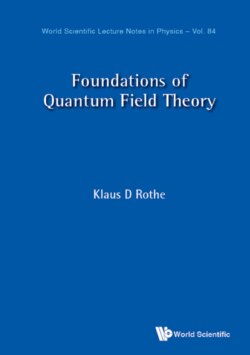Читать книгу Foundations of Quantum Field Theory - Klaus D Rothe - Страница 19
На сайте Литреса книга снята с продажи.
3.1A relativistic Schrödinger equation
ОглавлениеAs discussed in Chapter 1, the time evolution of a quantum mechanical state is governed by the equation of motion (ħ = c = 1)
where H is the Hamiltonian operator of the system obtained from the corresponding classical Hamiltonian by representing the canonically conjugate dynamical variables q and p in H(q, p) by operators satisfying canonical commutation relations. In this and the following two sections we consider the case of a free particle. Since in a relativistic theory the relation between the energy of a free particle and its momentum is given by , it is natural to take for the Hamiltonian
In the coordinate representation, the canonical commutation relations are as usual realized by
Defining the wave function associated with the state , one arrives thus at the wave equation
This equation in turn implies that is also a solution of the Klein–Gordon (KG) equation
where □ denotes the D’Alembert operator. Since this operator is manifestly Lorentz-invariant, covariance of the physical laws demand that under a Lorentz transformation the wave function transforms like a scalar:
This is also implied by Eq. (3.1), since on the space of solutions of the Klein–Gordon equation (3.2) the operator appearing on the left- and right-hand sides of Eq. (3.1) transform in the same way:
Note that in contrast to the non-relativistic case, where the wave function does not transform like a scalar, but rather picks up a phase under Galilei transformations, such a phase is absent in the relativistic case, rendering the covariance of the equation of motion manifest in this case.
The operator appearing on the rhs of Eq. (3.1) is defined in terms of its Taylor expansion:
Hence its eigenfunctions are given by the plane waves , with the corresponding eigenvalues . As a consequence, the action of this operator on any absolute integrable function in R3 is defined via its Fourier transform
as
The factor 1/2ω() has been included in the measure to make it relativistically invariant. In order for to be a solution of Eq. (3.1), we must further have
where . Hence, the most general solution to Eq. (3.2) has the form
In order for to be a Lorentz scalar, the Fourier coefficients will themselves have to be Lorentz scalars:
In the non-relativistic limit
so that we recover the Schrödinger 1-particle wave function of the non-relativistic theory. Since the argument of the exponential appearing in the Fourier integral is not Galilei-invariant, the corresponding non-relativistic field ϕnr(, t) does not transform as a scalar. In fact, each Fourier component will pick up a phase such as witnessed in Eq. (1.1) of Chapter 1. We therefore see that in this respect the transformation law in the relativistic case is simpler than in the case of Galilei transformations.
